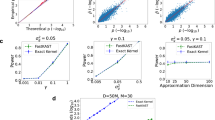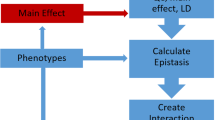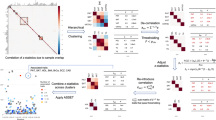Abstract
Our knowledge of the contribution of genetic interactions (epistasis) to variation in human complex traits remains limited, partly due to the lack of efficient, powerful, and interpretable algorithms to detect interactions. Recently proposed approaches for set-based association tests show promise in improving power to detect epistasis by examining the aggregated effects of multiple variants. Nevertheless, these methods either do not scale to large numbers of individuals available in Biobank datasets or do not provide interpretable results. We, therefore, propose QuadKAST, a scalable algorithm focused on testing pairwise interaction effects (also termed as quadratic effects) of a set of genetic variants on a trait and quantifying the proportion of phenotypic variance explained by these effects. We performed comprehensive simulations and demonstrated that QuadKAST is well-calibrated with good statistical power. We applied QuadKAST to 53 quantitative phenotypes measured in \(\approx 300,000\) unrelated white British individuals in the UK Biobank to test for quadratic effects within each of \(9,515\) protein-coding genes (after accounting for linear additive effects). We detected \(32\) trait-gene pairs across \(17\) traits that demonstrate statistically significant signals of quadratic effects (\(p \le \frac{0.05}{9,515\times 53}\) accounting for the number of genes and traits tested). Our method enables the detailed investigation of epistasis on a large scale, offering new insights into its role and importance.
B. Fu, P. Anand, A. Anand—Equal contribution.
Access this chapter
Tax calculation will be finalised at checkout
Purchases are for personal use only
Similar content being viewed by others
References
Boyang, F., Pazokitoroudi, A., Sudarshan, M., Liu, Z., Subramanian, L., Sankararaman, S.: Fast kernel-based association testing of non-linear genetic effects for biobank-scale data. Nat. Commun. 14(1), 4936 (2023)
Thornton-Wells, T.A., Moore, J.H., Haines, J.L.: Dissecting trait heterogeneity: a comparison of three clustering methods applied to genotypic data. BMC Bioinf. 7, 1–18 (2006)
Lunetta, K.L., et al.: Rare coding variants and X-linked loci associated with age at menarche. Nat. Commun. 6(1), 7756 (2015)
Li, X., et al.: Dynamic incorporation of multiple in silico functional annotations empowers rare variant association analysis of large whole-genome sequencing studies at scale. Nat. Genet. 52(9), 969–983 (2020)
Author information
Authors and Affiliations
Corresponding author
Editor information
Editors and Affiliations
Rights and permissions
Copyright information
© 2024 The Author(s), under exclusive license to Springer Nature Switzerland AG
About this paper
Cite this paper
Fu, B., Anand, P., Anand, A., Mefford, J., Sankararaman, S. (2024). A Scalable Adaptive Quadratic Kernel Method for Interpretable Epistasis Analysis in Complex Traits. In: Ma, J. (eds) Research in Computational Molecular Biology. RECOMB 2024. Lecture Notes in Computer Science, vol 14758. Springer, Cham. https://doi.org/10.1007/978-1-0716-3989-4_52
Download citation
DOI: https://doi.org/10.1007/978-1-0716-3989-4_52
Published:
Publisher Name: Springer, Cham
Print ISBN: 978-1-0716-3988-7
Online ISBN: 978-1-0716-3989-4
eBook Packages: Computer ScienceComputer Science (R0)




